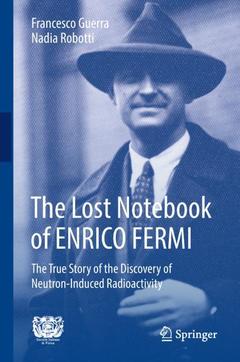The Lost Notebook of ENRICO FERMI, 1st ed. 2018 The True Story of the Discovery of Neutron-Induced Radioactivity
Auteurs : Guerra Francesco, Robotti Nadia

Introduction.- 1 Fermi in Italy: his handwritten manuscripts.- 2 Fermi Archive at the Domus Galilaeana in Pisa.- 3 A hole in the Archive.- 4 How do we proceed.- 5 The start of Nuclear Physics in Rome.- 6 Fermi and Nuclear Physics: the first steps.- 7 The first international congress of Nuclear Physics: Rome,October 1931.- 8 An accurate scientific planning.- 9 “Nuclear” electrons and the “neutrino” at the Rome congress.- 10 Nuclear Physics in Rome after the Rome Congress: 1931-1133.- 11 The discovery of the neutron.- 12 Fermi at the 1932 Paris Congress.- 13 Orso Mario Corbino and particle accelerators.- 14 The official start of Nuclear Physics in Rome: March 1933.- 15 New particles and new theories.- 16 The positron or “anti-electron”.- 17 The positron in the laboratory.- 18 The theory of nucleus according to Heisenberg-Majorana.- 19 Solvay Congress and Fermi theory of nuclear beta decay: October-Dicember 1933.- 20 The Seventh Solvay Congress.- 21 Fermi theory of beta decay.- 22 The discovery of alpha particle induced radioactivity.- 23 Frédéric Joliot and Irène Curie after the Solvay Congress.- 24 The discovery of alpha particle induced radioactivity.- 25 Why alpha particle induced radioactivity is discovered only in January.- 26 After the discovery.- 27 The discovery of neutron induced radioactivity.- 28 A project set aside.- 29 Gian Carlo Wick contribution.- 30 A very good starting point.- 31 A precedent case: Fluorine.- 32 The discovery of neutron induced radioactivity and the charge sign.- 33 After the discovery.- 34 Fermi strategic choices.- 35 A firm believe in the neutron.- 36 The choice of the source.- 37 The exploitation of the “geometry”.- 38 Fermi at work: chronicle of a discovery.- 39 The Hirpine Notebook.- 40 The right side of the notebook.- 41 The counter.- 42 The inverted periodic table.- 43 The moment of the discovery.- 44 From Aluminum to Fluorine and more.- 45 The investigation on the periodic table and the start of team work.- 46 The gamma rays from the source.- 47 First chemical analysis and new nuclear reactions.- 48 The date and the hour of the discovery.- 49 Further developments and conclusion.- Fermi publications during the italian period.- Appendix (Letters to Majorana).- References.- Name Index.- Figure captions and credits.- Pictures.- Pages from Hirpine Notebook and Loose Sheets.
Nadia Robotti is Full Professor of the History of Physics in the Department of Physics at the University of Genoa, and associated to the Italian National Institute for Nuclear Physics and the Enrico Fermi Research Center in Rome. Her research activity includes the history of quantum mechanics and atomic and nuclear physics. She has published around 150 research articles, as well as books and monographs. In 2008 she received the Prize for History of Physics from the Italian Physical Society. She is vice-director of the Giornale di Fisica and a member of the International Academy of the History of Science.
Reconstructs a turning point in the history of science by dissecting a previously lost original document
Offers a detailed, instructive account of the initial stages of the development of nuclear physics
Illustrates how guiding theoretical ideas are often crucial in achieving fundamental milestones in understanding
Includes supplementary material: sn.pub/extras
Date de parution : 01-2018
Ouvrage de 261 p.
15.5x23.5 cm
Disponible chez l'éditeur (délai d'approvisionnement : 15 jours).
Prix indicatif 137,14 €
Ajouter au panierDate de parution : 06-2019
Ouvrage de 261 p.
15.5x23.5 cm
Thème de The Lost Notebook of ENRICO FERMI :
Mots-clés :
history of nuclear physics; neutron-induced radioactivity; Enrico Fermi; Fermi's beta decay theory; Hirpine notebook; Physics Rome Congress: 1931; Paris Congress 1932; Orso Mario Corbino; Solvay Congress; Fermi's discovery of neutron-induced radioactivity; Oscar D'Agostino Archives; Artificial radioactivity
